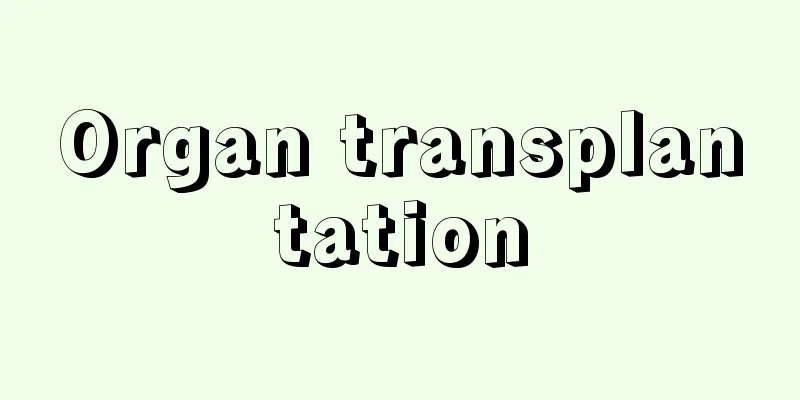Organ transplantation

|
It refers to the removal of an organ from its original location and transferring it to the same or another individual. The individual who provides the organ is called the donor, and the individual who receives the organ is called the recipient. [Hiroshi Nakamura] The significance of organ donors and organ transplantsDonors are divided into living and deceased donors. For living donors, the removal of organs must not pose significant risks or disadvantages to the donor's body. Organs essential to life, such as the heart, or organs that would severely impair bodily functions cannot be removed from living bodies. The target organs are the kidneys, liver, small intestine, and lungs. A prerequisite for living donors is that they are informed of the significance of organ removal and the associated risks, and consent to the removal surgery after fully understanding them. For deceased donors, there are cases where the donor is cardiac dead or brain dead, and the Organ Transplant Law applies. If the transplant is successful, the organ will obtain nutrients from its surroundings in the new location and perform its original functions. However, if the blood vessels of the organ are not promptly anastomosed with the blood vessels of the transplanted area to resume blood circulation, the organ tissue will die due to lack of oxygen and nutrients and the accumulation of harmful waste products. Organ transplants can save the lives of patients with fatal diseases because they replace the functions of the discarded organ. [Hiroshi Nakamura] Organ Transplant Law enactedIn some cases, such as living donor kidney transplants, healthy individuals may willingly offer to donate organs to their children or siblings, but in other cases, such as heart and cadaveric liver transplants, organs must be donated by brain-dead patients. Kidney and pancreas transplants can be done from non-heart-beating donors, but brain-dead donors have better results. In Japan, there have long been legal problems when it comes to extracting organs from cadavers. In 1979, the "Cornea and Kidney Transplant Law" was enacted, which for the first time legally permitted the extraction of kidneys from cadavers for kidney transplants. In June 1997, the "Organ Transplant Law" was enacted, making it possible to extract organs from brain-dead donors under certain conditions. For more information on this law, please refer to the Organ Transplant Law. [Hiroshi Nakamura] Types of Organ TransplantsThere are four types of organ transplants: (1) Autologous transplantation This refers to the transplantation of an organ to another part of the same individual in cases where conservative treatment is not possible and there is severe bilateral kidney damage, or when a large tumor has developed in the center of the kidney of a solitary kidney patient, the kidney is first removed and then repaired outside the body, or the tumor is removed and then the kidney is transplanted into the iliac fossa in the lower abdomen. There is no rejection reaction in autologous transplantation. (2) Syngeneic transplantation Transplantation between identical twins or animals of the same genetic lineage. As with autotransplantation, there is no rejection reaction and the organ survives permanently. (3) Allogeneic transplantation Transplantation of organs from one individual into another individual of the same taxonomic species (e.g., human to human) with a different genotype from the donor. Most of the transplants currently performed clinically belong to this category. If immunosuppression is not performed, rejection usually occurs. (4) Xenotransplantation Originally, transplantation between animals of different families in phylogenetic studies is called xenotransplantation, but in the Hominidae family, transplantation from primates of the same order, such as chimpanzees and baboons, to humans is called xenotransplantation. In fact, since the 1990s, the possibility of xenotransplantation from pigs to humans has been studied. However, even with the current advanced immunosuppression methods, transplanted organs are rejected and their function stops. When bacteria or viruses invade the body, the body's immune system works to defend against them, but a similar defense system also works against transplanted organs, causing a rejection reaction. Tissue compatibility tests, which are performed prior to organ transplantation, are nothing more than identifying the transplant antigens that an individual possesses. There are three types of tests: HLA type of lymphocytes, lymphocyte cross-matching test, and ABO type of red blood cells. [Hiroshi Nakamura] Kidney transplantationKidney transplantation was the first organ transplant to be widely performed clinically both in Japan and around the world. As of the end of 2008, 22,199 kidney transplants had been performed in Japan. At first, most were donor kidney transplants, but cadaveric kidney transplants, in which the kidney is removed after cardiac arrest, have also become available. However, donor kidney transplants account for only about 16% of kidney transplants in Japan, whereas in the United States, a leading country in organ transplantation, more than half are donor kidney transplants. Since the use of immunosuppressant calcineurin inhibitors cyclosporine and tacrolimus, kidney transplant outcomes have improved, with the one-year and five-year survival rates of about 96% and 91%, respectively, and the one-year and five-year survival rates of 91% and 79%, respectively, of donor kidney transplants. [Hiroshi Nakamura] Liver transplantationLiver transplants are the second most common transplant in Japan after kidney transplants. Globally, the vast majority of liver transplants are performed from brain-dead donors, but in Japan, due to the difficulty of obtaining organs from brain-dead donors, a method different from the global trend, living donor partial liver transplants, is used, and 5,249 have been performed as of the end of 2006. Around the world, approximately 8,300 brain-dead donor liver transplants are performed annually. In Japan, the first liver transplant from a brain-dead patient was performed in February 1999 under the Organ Transplant Law. With the establishment of liver transplant surgical techniques and the emergence of new immunosuppressants such as cyclosporine and tacrolimus, survival rates have improved to 82% at 1 year and 76% at 5 years. There is a unique transplantation technique called domino liver transplantation, in which the liver removed from the recipient is transplanted into another patient with end-stage liver failure, like falling dominoes. This is used when patients with an incurable disease called amyloidotic polyneuropathy (FAP) receive a liver transplant. [Hiroshi Nakamura] Heart transplantationHeart transplants had not been performed in Japan since the so-called Wada transplant (Japan's first heart transplant operation, performed by Wada Juro, a professor at Sapporo Medical University) in August 1968 (Showa 43), but 31 years later, in February 1999 (Heisei 11), a heart transplant was performed in accordance with the Organ Transplant Law. Since then, as of December 2008, 60 cases have been performed. Since the heart suffers severe tissue damage when blood flow stops in the body, heart transplants require organs to be received at the brain-dead stage, and the heart must be transplanted within four hours of being removed from the brain-dead donor. Approximately 3,800 heart transplants are performed annually around the world, and the procedure has become a routine treatment. Clinical outcomes have improved since the use of combination therapy with calcineurin inhibitors (cyclosporine, tacrolimus), mycophenolate mofetil (azathioprine was used in the early stages), and steroids. According to the Japan Heart Transplant Study Group, there were only two deaths in 60 cases (after four months and four years and two months), and the survival rates were 99% at three years and 94% at five and ten years. [Hiroshi Nakamura] Lung transplantationLung transplants are performed approximately 1,300 times a year worldwide, and are well established as a treatment for severe lung diseases for which there is no other treatment option. Simultaneous heart-lung transplants, in which the heart and lungs are transplanted at the same time, are also performed. In Japan, according to the Japan Society of Lung and Cardio-Lung Transplantation, since the first lung transplant was performed in 1998, a total of 138 cases have been performed by May 2009, including 58 deceased donor lung transplants and 80 living donor lung transplants. The first lung transplant from a deceased donor under the Organ Transplant Law was performed in March 2000. The five-year survival rate for living donor lobe transplants is 80%, and the five-year survival rate for deceased donor lung transplants is 66%, both of which exceed the survival rate in the international registry (49%). [Hiroshi Nakamura] Small bowel transplantationSmall intestine transplants are performed on people who are unable to absorb nutrients from the intestine due to some cause, such as congenital short bowel syndrome. Rejection reactions are more likely to occur with small intestine transplants than with other organ transplants, and the number of transplants performed worldwide is less than that of other organ transplants. In Japan, the first living donor small intestine transplant was performed at Kyoto University in 1996, and as of December 2007, 14 small intestine transplants have been performed in 12 cases, 11 of which were transplants from living donors. Although the results were poor compared to other organ transplants, the survival rate has improved since mycophenolate mofetil (MMF) was added to tacrolimus and steroids, and as of August 2008, the 1-year survival rate was 83% and the 5-year survival rate was 59%. [Hiroshi Nakamura] Pancreas transplantationThere are two types of pancreas transplantation: whole or partial pancreas transplantation and islet transplantation. In the former, vascular anastomosis is used to transplant all or part of the pancreas, while in the latter, islets (endocrine tissue scattered like islets in pancreatic tissue) are separated from the pancreas and injected into the liver through a thin tube inserted through the skin into the patient's portal vein. The islets scattered in the liver are surrounded by capillaries and survive. Pancreas transplantation may also be performed at the same time as or after kidney transplantation. According to the Pancreas and Islet Transplantation Research Society, since the first simultaneous pancreas-kidney transplantation was performed on April 25, 2000, after the Organ Transplantation Law was enacted in October 1997, 59 simultaneous pancreas-kidney transplants have been performed under brain death and two under cardiac arrest as of May 2009. Nine pancreas transplants from living donors have also been performed. The three-year survival rate of transplanted pancreas is 98%, and the three-year survival rate is 77%. [Hiroshi Nakamura] Tissue transplantationTransplants of corneas, skin, blood vessels, bones, ossicles, heart valves, and cerebral dura mater have also been performed clinically, but these are classified as tissue transplants rather than organ transplants. [Hiroshi Nakamura] Immunosuppressant therapyImmunosuppressive therapy is used to enable the recipient to accept the transplanted organ without rejection. There are many types of immunosuppressants, but the main ones used are calcineurin inhibitors (cyclosporine, tacrolimus), mycophenolate mofetil, and steroids. [Hiroshi Nakamura] How to Treat RejectionIn the past, localized radiation therapy was used to treat acute rejection, but currently, methylprednisolone pulse therapy (high doses administered in a short period of time) is used first, followed by an increase in the amount of steroids, which are then gradually tapered. In cases of rejection that do not respond to these or vascular rejection, OKT3 monoclonal antibody is administered. There is currently no effective treatment for chronic rejection. [Hiroshi Nakamura] Preserving organs for transplantationOrgans die rapidly when they are deprived of blood (they become ischemic). This process can be slowed down by cooling, but it cannot be stopped completely. Therefore, in the case of brain-dead donors, in-cadaver cold perfusion is performed by injecting cooled perfusion fluid through the aorta and portal vein. Organs are removed in the order in which they are most susceptible to warm ischemic damage, namely the heart, lungs, liver, pancreas, and kidneys, and a preservation solution called UW solution or Euro-Collins solution (a high potassium, low sodium, high magnesium electrolyte solution with glucose and mannitol added to give it a high osmolality) cooled to 4°C is immediately injected through the inflow blood vessels to wash out the blood from within the organs, and the organs are cooled from the inside, after which they are immersed in the preservation solution and stored at 0-4°C. UW solution was developed by Belzer of the University of Wisconsin. It contains substances that do not easily pass through cell membranes, and has a higher osmotic pressure than plasma, preventing cellular acidosis (accumulation of acid) and preventing cell damage caused by active oxygen and free radicals (free radicals, reactive groups with extremely high reactivity and a very short half-life) that are generated when blood flow is resumed after transplantation. UW solution also contains precursors necessary for the resynthesis of ATP (adenosine triphosphate, a compound found in all cells that serves as a source of stored energy), which rapidly decreases during cryopreservation. The preservation limits for each organ are 4 hours for the heart, 6 hours for the lungs, 12 hours for the liver, 24 hours for the pancreas, and 48 hours for the kidneys. [Hiroshi Nakamura] "From Life to Life: Organ Transplantation" by Suzuki Morikazu (1998, Kairyusha)" ▽ "From the Frontline of Organ Transplantation" by Ota Kazuo (1999, Yodosha)" ▽ "What is the Problem with Brain Death and Organ Transplantation? Focusing on the Theory of the Right to Die and the Value of Life" by Shinohara Mutsuji (2001, Gendaishokan)" ▽ "Anesthesia for Organ Transplantation" edited by Hirakawa Masahisa (2002, Katsuseido Publishing) ▽ "Organ Transplantation and Bioethics" edited by Kuramochi Takeshi and Nagashima Takashi (2003, Taiyo Publishing) ▽ "Issues in the Revision of the Organ Transplant Law" edited by Machino Saku, Nagai Madoka, and Yamamoto Teruyuki (2004, Shinzansha Publishing) ▽ "Medical Anthropology of Brain Death and Organ Transplantation" by Margaret Locke, translated by Sakagawa Masako (2004, Misuzu Shobo)" ▽ "Takahashi Kota, 'Indications and Ethics of Living Organ Transplants: Considering Ethical Issues' (2007, Nihon Igakukan) " "Aikawa Atsushi, 'Organ Transplants in Japan: The Jihad of a Kidney Transplant Doctor in Practice' (2009, Kawade Shobo Shinsha)" [References] | | | | | | | | | | |Source: Shogakukan Encyclopedia Nipponica About Encyclopedia Nipponica Information | Legend |
|
本来存在している部位から臓器をいったん摘出し、同一またはほかの個体にそれを移すことをいう。臓器を提供する個体をドナー(donor、提供者)、臓器を受ける個体をレシピエント(recipient、受容者)という。 [中村 宏] 臓器提供者と臓器移植の意義ドナーは生体ドナーと死体ドナーとに区別される。生体ドナーでは、臓器の摘出が、ドナーの身体に及ぼす危険性、不利益が大きくないことが必要で、生命維持に不可欠な心臓などの臓器や、身体機能が著しく損なわれる臓器を生体から摘出することはできず、腎臓(じんぞう)・肝臓・小腸・肺が対象臓器となる。生体ドナーは、臓器摘出の意義や随伴する危険性について説明を受け、十分理解したうえで摘出手術に承諾することが前提条件となる。死体ドナーは、心臓死の場合と、脳死の場合とがあり、臓器移植法が適用される。移植が成功すれば、新しい場所でその周囲から栄養をとり、その臓器本来の機能を営むようになる。しかし、臓器の血管を、移植された部位の血管と速やかに吻合(ふんごう)して血行を再開させないと、酸素と栄養分の欠如および有害な老廃物の蓄積のために臓器の組織が死んでしまう。臓器移植は、廃絶した臓器にとってかわってその機能を営むので、致命的な疾患では患者を救命することができる。 [中村 宏] 臓器移植法の成立移植される臓器は、生体腎移植のように健常人が自分の意思によって子や兄弟姉妹に提供を申し出る場合もあるが、心臓移植や死体肝移植などでは脳死患者から臓器の提供を受ける必要がある。腎移植や膵(すい)移植では、心停止ドナーからでも可能だが、脳死ドナーからのほうが成績がよい。日本では死体から臓器を摘出する際、長い間法律的に問題があった。1979年(昭和54)に「角膜及び腎臓の移植に関する法律」が成立し、腎移植に使用されるための腎臓を死体から摘出することが法律的に初めて認められるようになった。1997年(平成9)6月には「臓器移植法」が成立し、条件付きで脳死ドナーからの臓器摘出が可能となった。なお、同法の詳細については臓器移植法の項目を参照されたい。 [中村 宏] 臓器移植の種類臓器移植には次の4種類がある。 (1)自家移植 保存的療法が不可能な両側性の重篤な腎臓損傷や、単腎者の腎臓の中央部に大きな腫瘍(しゅよう)が発生した場合に、腎臓をいったん摘出して、体外において腎臓を修復、または腫瘍を摘出した後に、その腎臓を下腹部の腸骨窩(ちょうこつか)に移植する場合のように、臓器を同一個体のほかの部位に移植することをいう。自家移植では拒絶反応は起こらない。 (2)同系移植 一卵性双生児間、または遺伝的に同一の系に属する動物間で移植することをいう。自家移植と同様に拒絶反応は起こらず、臓器は永久に生着する。 (3)同種移植 ある個体から得た臓器を、動物分類学上同一の種に属する(たとえばヒトからヒトへなど)、ドナーとは異なった遺伝子型をもつほかの個体に移植することをいう。現在の臨床的に行われている移植医療のほとんどがこれに属する。免疫抑制法を行わないと通常拒絶反応が起こる。 (4)異種移植 本来系統発生学上、科の異なる動物間での移植のことをさすが、ヒト科では同じ目(もく)である霊長類、たとえばチンパンジーやヒヒからヒトへの移植などを異種移植とよんでいる。実際、1990年代に入ってからは、ブタからヒトへの異種移植の可能性が研究されている。しかし、現在の進歩した免疫抑制法を用いても、移植された臓器は拒絶反応を受けてその機能は止まってしまう。 細菌やウイルスが体内に侵入すると、生体はこれらを防御しようとして免疫機構が働くが、移植された臓器に対しても同様な防御システムが働き、拒絶反応を起こしてしまう。臓器移植に先だって行われる組織適合性検査は、個人のもっている移植抗原を同定することにほかならない。これにはリンパ球のHLA型、リンパ球交叉(こうさ)試験、赤血球のABO型の三つがある。 [中村 宏] 腎移植腎移植は、世界的にも、また日本でも、臓器移植のなかで、最初に広く臨床的に行われるようになった。日本では2008年(平成20)末までに2万2199回の腎移植が行われている。最初のうちはほとんどが生体腎移植であったが、心停止後に腎臓を摘出して移植する献腎移植(死体腎移植のこと)も行われるようになった。しかし腎移植件数のうち献腎移植の占める割合は、日本では約16%にすぎないが、臓器移植の先進国のアメリカ合衆国では半数以上は献腎移植となっている。免疫抑制剤のカルシニューリン阻害薬であるシクロスポリン(サイクロスポリン)、タクロリムスが使用されるようになってから腎移植の成績は向上し、生体腎移植生着率は1年約96%、5年約91%で、献腎移植でも1年91%、5年79%という良好な生着率が得られている。 [中村 宏] 肝臓移植肝臓移植は腎移植に次いで日本で多く行われている。世界的には肝移植というと脳死肝移植が大部分を占めるが、日本では脳死者からの臓器提供がむずかしいため、生体部分肝移植という世界の動向とは違った方法がとられ、2006年末までに5249回施行されている。脳死肝移植は世界では年間約8300回行われている。日本でも臓器移植法に基づく脳死患者からの肝移植が1999年2月に初めて行われた。肝移植手術手技の確立、シクロスポリン、タクロリムスなど新しい免疫抑制剤が出現し、生存率は1年82%、5年76%と向上した。 ドミノ肝移植という特殊な移植法があるが、これはドミノ倒しのように、肝移植を受ける患者から摘出された肝臓をほかの肝不全末期の患者に移植する方法である。アミロイド・ポリニューロパシー(FAP)という難病の患者が肝移植を受けるときに行われる。 [中村 宏] 心臓移植心臓移植は1968年(昭和43)8月に行われたいわゆる和田移植(札幌医科大学教授であった和田寿郎(じゅろう)による日本初の心臓移植手術)以来日本では施行されていなかったが、31年後の1999年(平成11)2月に臓器移植法にのっとった心臓移植が行われた。その後2008年12月までに60例施行されている。心臓は生体内で血流停止が起こると強い組織障害を受けるので、心臓移植は脳死の段階で臓器の提供を受けることが不可欠で、脳死者から心臓を摘出した後4時間以内に移植されなければならない。世界では年間約3800回施行されていて、いまや日常的な治療法となっている。カルシニューリン阻害薬(シクロスポリン、タクロリムス)、ミコフェノール酸モフェチル(初期にはアザチオプリンが用いられた)、ステロイドの三者併用療法が行われるようになってから臨床成績は向上し、日本心臓移植研究会によると、死亡例は60例中2例のみ(4か月後と4年2か月後)で、生存率は3年99%、5年、10年94%である。 [中村 宏] 肺移植肺移植は世界的には、年間約1300回施行され、移植以外に治療法のない重症肺疾患の治療法として定着している。また心臓と肺を同時に移植する心肺同時移植も行われている。日本では、日本肺および心肺移植研究会によれば、1998年に初の肺移植が行われて以来、2009年5月までに58例の脳死肺移植と、80例の生体肺移植の合計138例が施行された。臓器移植法に基づく脳死者からの肺移植は、2000年3月に初めて行われた。生体肺葉移植の5年生存率は80%、脳死肺移植の5年生存率は66%であり、いずれも国際登録の生存率(49%)を上回っている。 [中村 宏] 小腸移植小腸移植は、先天性短腸症候群など、何らかの原因で腸から栄養を吸収できない人に対して行われる。ほかの臓器移植よりも拒絶反応が起こりやすく、世界的にもほかの臓器移植よりも施行回数が少ない。日本では、1996年に京都大学で第1例目の生体小腸移植が施行され、2007年12月までに12例に対し14回の小腸移植が行われているが、このうち11回は生体ドナーからの移植である。ほかの臓器移植と比べると成績は悪かったが、タクロリムス、ステロイドにミコフェノール酸モフェチル(MMF)を追加するようになってから、生存率は向上し、2008年8月までの生存率は、1年83%、5年59%である。 [中村 宏] 膵臓移植膵臓移植には全または部分膵移植と膵島移植とがある。前者では血管吻合(ふんごう)を行って膵臓全部または一部を移植するが、後者では膵臓から膵島(膵臓組織中に島のように散在する内分泌組織)を分離し、皮膚を通して患者の門脈に挿入した細いチューブから肝臓に膵島を注入する。肝臓内に散らばった膵島は毛細血管に取り囲まれて生着する。腎移植と同時または腎移植後に膵移植を行うこともある。膵・膵島移植研究会によれば、1997年10月臓器移植法の施行後、2000年4月25日に第1例目の膵腎同時移植が行われてから、2009年5月までに、59例の脳死下での膵臓移植と2例の心停止下での膵腎同時移植が行われた。なお生体ドナーからの膵臓移植も9例行われている。移植膵の3年生存率98%、3年生着率は77%である。 [中村 宏] 組織移植なお角膜、皮膚、血管、骨、耳小骨、心臓弁、脳硬膜などの移植も臨床的に行われているが、これらは臓器移植ではなく、組織移植に属する。 [中村 宏] 免疫抑制療法レシピエントが、拒絶反応を起こすことなく移植された臓器を受け入れられるように、免疫抑制療法が行われる。免疫抑制剤には多種類あるが、主としてカルシニューリン阻害薬(シクロスポリン、タクロリムス)、ミコフェノール酸モフェチル、ステロイドなどが用いられている。 [中村 宏] 拒絶反応の治療方法急性拒絶反応の治療としては、以前には放射線局所照射も行われたが、現在ではまずメチルプレドニソロンのパルス療法(短期間に大量投与すること)後、ステロイドを増量し、以後漸減する。これらに反応しない拒絶反応や血管型拒絶反応ではOKT3モノクローナル抗体を投与する。慢性拒絶反応に対しては、現在のところ有効な治療法はない。 [中村 宏] 移植用臓器の保存臓器は血液の供給がない(阻血状態になる)と急速に死滅する。冷却によってその過程を遅らせることはできるが、完全に止めることはできない。したがって脳死ドナーの場合には、大動脈と門脈から冷却した灌流(かんりゅう)液を注入して死体内冷却灌流を行う。温阻血(おんそけつ)障害を受けやすい順序、すなわち心臓、肺、肝臓、膵臓、腎臓の順に摘出し、ただちに流入血管から4℃に冷却したUW液またはユーロ・コリンズEuro-Collins液(高カリウム、低ナトリウム、高マグネシウムの電解質組成液にブドウ糖とマンニットを加えて高浸透圧にした液)という保存液を注入して臓器内の血液を洗い出すとともに、臓器を内部から冷却した後、保存液中に浸漬(しんし)し、0~4℃下で保存する。UW液はウィスコンシン大学University of WisconsinのベルツァーBelzerが開発したもので、細胞膜を通過しにくい物質を含有し、浸透圧は血漿(けっしょう)よりも高く、細胞のアシドーシス(酸の蓄積)の発生を防止し、移植後血流を再開したときに発生する活性酸素やフリーラジカル(遊離基。反応性が著しく高く、半減期が非常に短い反応基)による細胞障害を防止する。またUW液は、低温保存中に急速に減少するATP(adenosinetriphosphate、アデノシン三リン酸。あらゆる細胞中にみられる化合物で、エネルギーの貯蔵源となる)の再合成に必要な前駆物質を含有する。各臓器の保存限界は、心臓が4時間、肺が6時間、肝臓が12時間、膵臓が24時間、腎臓が48時間である。 [中村 宏] 『鈴木盛一著『生命(いのち)から生命(いのち)へ「臓器移植」』(1998・海竜社)』▽『太田和夫著『臓器移植の現場から』(1999・羊土社)』▽『篠原睦治著『脳死・臓器移植、何が問題か――「死ぬ権利と生命の価値」論を軸に』(2001・現代書館)』▽『平川方久編『臓器移植の麻酔』(2002・克誠堂出版)』▽『倉持武・長島隆編『臓器移植と生命倫理』(2003・太陽出版)』▽『町野朔・長井円・山本輝之編『臓器移植法改正の論点』(2004・信山社出版)』▽『マーガレット・ロック著、坂川雅子訳『脳死と臓器移植の医療人類学』(2004・みすず書房)』▽『高橋公太著『生体臓器移植の適応と倫理――倫理問題を考える』(2007・日本医学館)』▽『相川厚著『日本の臓器移植――現役腎移植医のジハード』(2009・河出書房新社)』 [参照項目] | | | | | | | | | | |出典 小学館 日本大百科全書(ニッポニカ)日本大百科全書(ニッポニカ)について 情報 | 凡例 |
<<: Early type star - Soukigatasei
>>: Sogi (English spelling) zou-yi; tsou-i
Recommend
"Akahata Sunday Edition" - Akahata Sunday Edition
...However, with the coming into force of the Pea...
Masako Hojo
Year of death: 16 August 1225 (11 July 1225) Year ...
Milton, J.
…English poet. In the history of English poetry, ...
Work and tribute diagram
Genre painting from China. "Official tribute&...
Sea cactus - Sea cactus
A marine animal belonging to the phylum Coelenter...
DEFA
The German film industry was led by the German di...
Kudzu Chang Geng - Kudzu
…A Taoist priest from the Southern Song Dynasty i...
External cooperation - kakugai kyoryo
When a political party that is not participating i...
Georg Wilhelm Steller
1709‐46 German naturalist. Born in the Kingdom of ...
Ahidjo, A. (English spelling) AhidjoA
...Western Cameroon divided into the north and so...
VIA Rail (English)
...Based on the Canadian National Railways Act en...
Transfer of certificate - Korobishomon
"Korobi" refers to a Christian who renou...
Gandhi and Lenin
…He was a supporter of Tilak and then approached ...
Aiyam - Aiyam
...Medina inherited the traditions of the Prophet...
《Iskender Name》
In the early 14th and 15th centuries, the pioneer...









